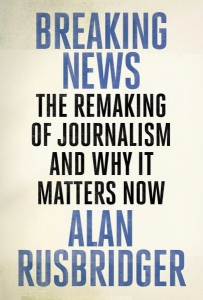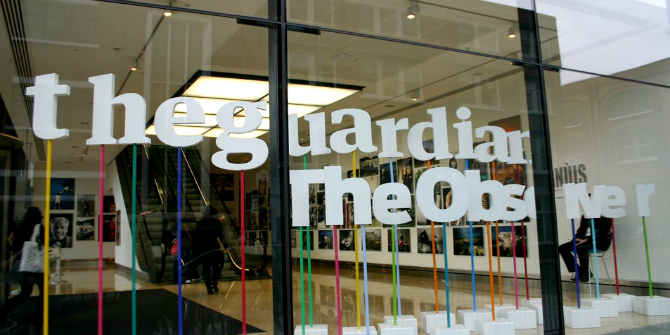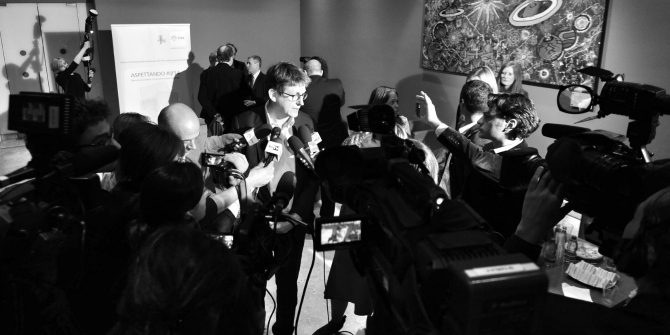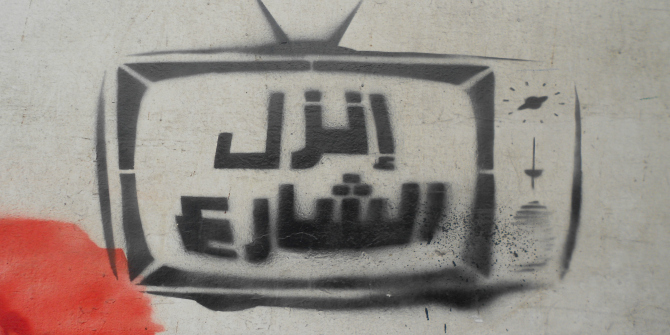In Breaking News: The Remaking of Journalism and Why it Matters Now, former Guardian editor Alan Rusbridger offers an appraisal of news media today, drawing on his experience at the helm of the British newspaper that broke notable news stories relating to phone hacking, Wikileaks and the National Security Agency (NSA) revelations. While the book could include more self-reflection when it comes to Rusbridger’s business decisions as editor, this is a vital read for anyone interested in the viability of our media in the digital era, recommends Peter Carrol.
Breaking News: The Remaking of Journalism and Why it Matters Now. Alan Rusbridger. Canongate. 2018.
 Find this book (affiliate link):
Find this book (affiliate link): ![]()
Who decides whether the media serves the public interest? This question, raised by a Facebook employee during a private meeting with the Guardian about how tech companies could support journalism, is one that Alan Rusbridger returns to many times in his memoir, Breaking News.
By the end of the book, Rusbridger, editor of the Guardian between 1995 and 2015, acknowledges there is little sign of consensus on the issue that came to define his tenure. The period saw huge changes for the centre-left daily newspaper: vast new audiences through the internet, celebrated scoops on phone-hacking and global technology surveillance and, most critically for Rusbridger, the intense challenge of creating a financially viable online news company that serves social and democratic objectives.
The book begins in the summer of 1976, when Rusbridger, newly graduated in English Literature from Cambridge University, moved a mile from his old colleges to join the Cambridge Evening News. Rusbridger vividly describes the tough world of 1970s news production: phoning in copy from the field, working to 6pm deadlines, when typesetters took over to lay out the paper before printing in the early hours of the morning. Alcohol was a prominent part of the working day, with Rusbridger holding drinking wagers based on how many clichés made it into the sports reports. He learns his trade alongside veteran reporters like Jock, who drilled into Rusbridger the journalistic creed of ‘kicking [those in authority] in the balls at regular intervals, because, in the long run, they needed us more than we needed them’.
After three years in Cambridge, Rusbridger took his clippings to London to secure a job at the Guardian. A swift ascent up the newspaper’s ranks followed, with spells as a feature writer and diarist, interrupted by brief periods at the Observer and a short-lived paper called the London Daily News (the latter described in relatively little detail). He finally returned to the Guardian in the late 1980s, taking over from long-serving editor Peter Preston in 1995, becoming only the paper’s tenth editor in its 176-year history.
Image Credit: Crop of ‘The guardian and the observer’ by Michael Brunton-Spall licensed under CC BY 2.0
The start of Rusbridger’s tenure was marked by a bruising libel case with Conservative MP Jonathan Aitken, and leading the paper on its first, uneasy steps into the uncharted territory of the ‘world wide web’. Visits to the emerging internet industry on the US’s West Coast filled Rusbridger with optimism that freedoms over the format and global audience potential would transform the news industry. He approved extra investment in digital to grow the team of young internet pioneers to work ‘in the basement’ and develop the Guardian’s website.
Rusbridger’s decision yielded early returns when the Guardian’s website gained global exposure following the 9/11 terror attacks on America, with page views growing from 29 million to 51 million in two months. Rusbridger interpreted this growth as evidence that global audiences were being underserved by news providers in their native countries. But UK readers soon realised they could access the printed product, regularly updated in a more convenient form on their computer screens, free of charge. As these readers rapidly deserted the print version of the Guardian and moved online, any hope that lost cover price revenues would be offset by income from web advertising were dashed as internet rivals like Craig’s List emerged to dominate the classified advertising market. Google and then Facebook grew to near-monopoly status on internet advertising: by 2017, the tech giants were controlling an estimated 63% of digital-advert spending in the US, mainly as a platform for external content and targeting audiences with ruthless efficiency.
These waves of disruption left Rusbridger and his generation of journalists struggling to salvage the business model that had sustained private media for centuries:
the floodgates opened, and as billions of people also gained access to information and could publish themselves journalism struggled to adjust. Newspapers began to die in front of our eyes.
The Guardian, always ‘teetering on the brink between profitability and loss’, sunk deeply into the red with operating losses swelling to an estimated £40 million by 2010. UK broadsheet competitors also struggled, and Rusbridger dedicates large sections to how the Guardian’s rivals – chiefly, The Telegraph, the Financial Times (the FT), The Times and The Independent – also navigated the challenges of the information age.
The Independent, which was unable to maintain circulation after a successful launch in the mid-1980s, eventually moved towards impactful, image-dominated front pages with a campaigning edge to attract attention. At The Times, situated within Rupert Murdoch’s vast media empire, editorial standards were largely maintained while losses were concealed by opaque accountancy practices attributing many of the paper’s operations to other parts of his business.
Rusbridger offers a compelling editorial and business analysis of both The Telegraph and the FT to show how profitability was achieved at these titles. A whole chapter is dedicated to what Rusbridger views as the terminal decline in editorial quality of The Telegraph since 2004, when the paper was taken over by the secretive billionaire Barclay brothers, through relentless staff cuts. Rusbridger describes how the newspaper’s shielding of its high-spending advertising clients, such as HSBC bank, from negative coverage has seriously damaged the paper’s credibility. Citing numerous off-the-record accounts from former Telegraph journalists, Rusbridger paints a persuasive account of a venerable British institution ruined by its obsession with achieving a profit. Meanwhile, the FT intensified its focus on high-earning readers, exemplified in its weekly supplement ‘How To Spend It’. Rusbridger ridicules the section’s features, which provide shopping and lifestyle tips for the extremely wealthy, over several pages; the message is that in its prioritisation of the rich, the FT no longer fills its social role, an essential function of the media.
Rusbridger finds a kinship in this area between the Guardian and the New York Times (a paper which receives a number of admiring notices throughout the book). At one point he recounts exchanging ideas with their executive editor on why the ‘gated community model’ – where the minority of well-educated, wealthy readers receive high-quality, accurate information, while the majority of society does not – has serious negative ramifications for democracy. This ethos guided the Guardian’s high standards during Rusbridger’s editorship. He refused to budge on quality journalism by only supporting substantive news coverage: ‘We broke virtually no celebrity news or gossip. We tended to ignore people’s private lives.’ This commitment means that a major part of Rusbridger’s legacy is a newspaper that is the most widely read and most trusted in the UK.
Image Credit: ‘Alan Rusbridger – editor The Guardian – (backstage)’ by Alessio Jacona/International Journalism Festival licensed under CC BY SA 2.0
Integral to Rusbridger’s editorial standards was solid support for investigative journalism, evidenced in the run of landmark scoops, a record that is peerless amongst his generation of editors. The phone-hacking scandal, Wikileaks and the National Security Agency (NSA) revelations based on the leaks of Edward Snowden were the most notable successes. Rusbridger describes the journalistic processes and ethical questions each of these stories posed in fascinating detail.
In 2005, Rusbridger was approached by Nick Davies, a star investigative reporter at the Guardian who happened to join the paper on the same day as he did in 1979. Davies wanted to dig into allegations of phone hacking by journalists; authorising the investigation would mean the Guardian broke a Fleet Street code of not attacking rival newspapers. Rusbridger gave Davies the green light anyway, and the Guardian pursued the story independently, at great expense, over the next four years. By 2009, Davies reported widespread phone-hacking at Murdoch’s News International, where employees speculatively targeted the phones of individuals in the public eye, as well as their friends and families, to secure information about their private lives. After the Guardian reported the story, they endured sustained criticism from their rivals, but by 2011 the investigation had led to the closure of Murdoch’s highly profitable 168-year-old News of the World, and prompted a government-ordered judicial public inquiry into media ethics in the UK.
The two other journalistic triumphs to which Rusbridger devotes chapters – Wikileaks and the NSA revelations – both brought the paper international acclaim and profile. In particular, the reporting of blanket surveillance by the NSA provoked fierce debates around the world over uses of technology and civil liberty. Almost all the UK press were critical towards the Guardian’s Pulitzer Prize-winning story, but almost half a decade on it is hard to argue that surveillance through technology is not an issue of vital importance (further highlighted by Facebook’s selling of data during the EU referendum campaign, reported as part of the Cambridge Analytica story broken by Carole Cadwalladr at the Guardian’s sister paper, the Observer, after Rusbridger’s departure). The singular pursuit by the Guardian of these stories, and the criticism the paper weathered in their aftermath, leaves the reader with the impression that in the struggle to survive in the digital era, much of the British media has seriously lost its way.
Rusbridger’s prodigious reputation as an editor contrasts unfavourably with the major business decisions he made, an aspect of his legacy of which he offers little analysis compared to his journalistic record. The most notorious of these was to spend an estimated £80 million in 2004 to build new presses to print the Guardian in Berliner format. The investment in print coincided with the moment newspaper circulations began their rapid decline; but Rusbridger makes a decent case for how it was the most sensible choice for the paper at the time. Of the options available to the Guardian, renting presses to continue to print the paper in broadsheet would also have been costly, while if it downsized to the smaller tabloid-sized paper, as The Times and The Independent both did, the huge number of job adverts the Guardian ran meant each edition would have run to a weighty 220 pages. A further criticism, which is indivisible from Rusbridger’s commitment to high-quality journalism, was that the paper was overstaffed. Rusbridger briefly acknowledges that editorial costs were probably too high, but then deflects blame for this onto the Guardian’s board for not acting fast enough to shed jobs.
Although Rusbridger downplays these decisions, a sense of his former colleague’s feelings towards him came after his departure in 2015 when he was lined up, and then ‘blocked’, as Chair of the Guardian’s Scott Trust (the company that owns the Guardian and other media assets). The Times reported ‘furious’ former colleagues vetoed Rusbridger’s appointment, blaming him for the Guardian’s huge financial losses. Whether or not this report is accurate (Murdoch’s Times is unlikely to be neutral observer on Rusbridger), you feel that Rusbridger could have shown more introspection on his business decisions in his memoir, where his accounts can appear overly defensive and brief, especially in relation to the thorough analysis his broadsheet rivals receive.
As Breaking News nears its conclusion, Rusbridger notes that ‘this is a story half told’. The Guardian, like most of the private media, finds itself in a deeply challenging situation as the digital era matures; Rusbridger’s message is that if the ethical basis for your journalism is solid, at a minimum, the media will hold power to account and bring important issues to public attention. Many would concede the Guardian, more than any other news organisation in the modern era, has made a unique and valuable contribution to public life in the twenty-first century. For anyone interested in the viability of our media in the digital era, Rusbridger’s memoir is a vital read.
Note: This review gives the views of the author, and not the position of the LSE Review of Books blog, or of the London School of Economics and Political Science. The LSE RB blog may receive a small commission if you choose to make a purchase through the above Amazon affiliate link. This is entirely independent of the coverage of the book on LSE Review of Books.









2 Comments